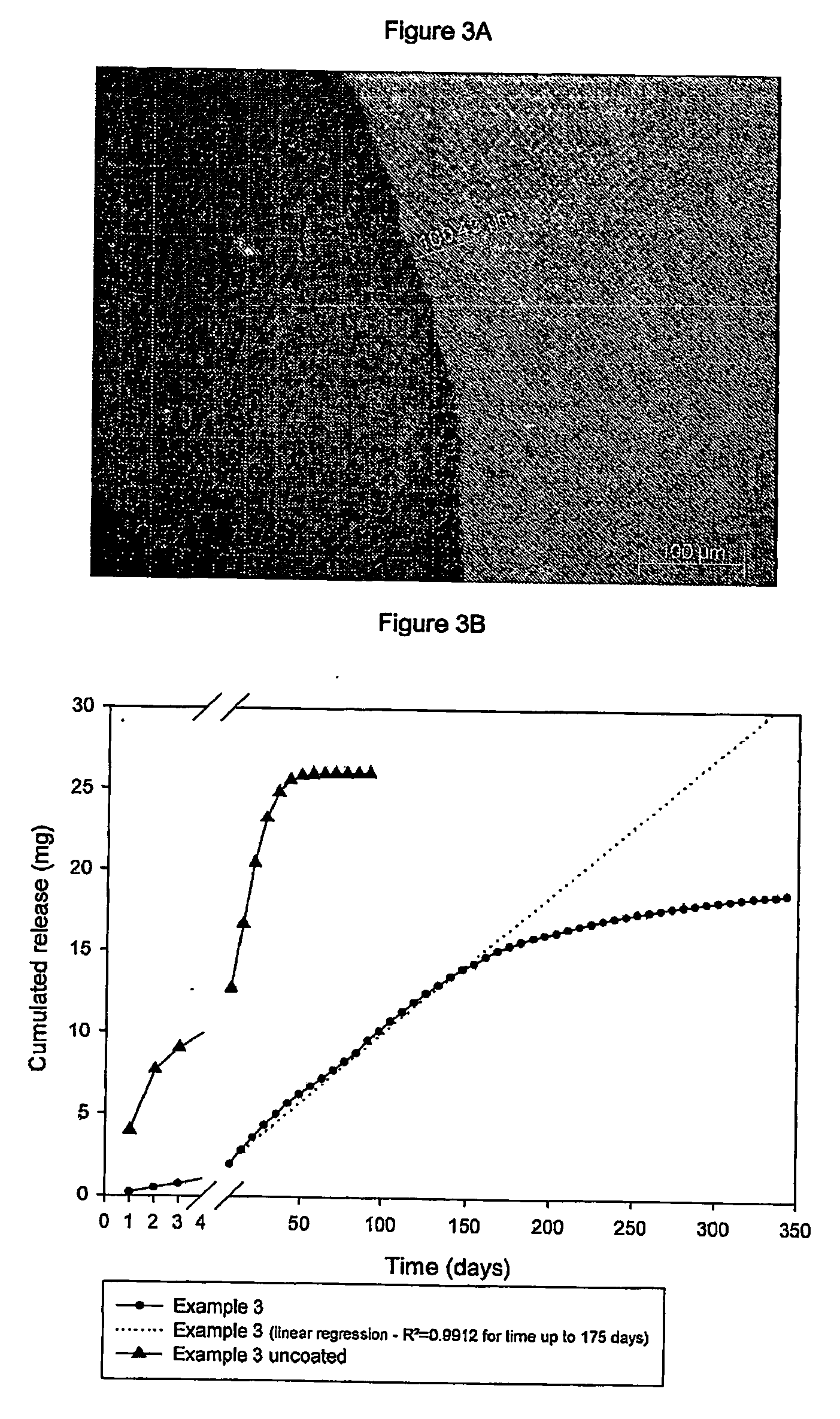Subcutaneous implants having limited initial release of the active principle and subsequent linearly varying extended release thereof
a technology of subcutaneous implants and active principles, which is applied in the direction of prosthesis, peptide/protein ingredients, drug compositions, etc., can solve the problems of incompatible diffusion of active principles through polymers, high total amounts of active principles can be achieved, and available subcutaneous implants have the disadvantage of releasing this type of active principle, etc., to achieve the effect of reducing the initial burst release rate, reducing the diffusion rate at the first stage of release, and facilitating drug dissolution
- Summary
- Abstract
- Description
- Claims
- Application Information
AI Technical Summary
Benefits of technology
Problems solved by technology
Method used
Image
Examples
example 1
Preparation of Subcutaneous Implants Containing Avorelin
[0122] Subcutaneous implants containing 23.5% mass / mass Avorelin and 76.5% mass / mass PLGA (molar ratio 72 / 28-Average molecular weight 115,000 Da) are prepared as described in WO00 / 33809 and passed for 1 second into a solution of PLGA (molar ratio lactic acid / glycolic acid: 74 / 26-Average molecular weight 115,000 Da) in methylene chloride at 173.5 g / l. This is followed by drying the implants treated with said solution in a stream of air. Finally, implants are sterilised by Gamma irradiation at 25 KGy.
[0123]FIG. 1A shows an enlarged (150×) cross-section image taken at the above optical microscope of one of the aforesaid coated implats . The coating thickness is about 12 μm in the photographed portion.
[0124]FIG. 1B shows the in-vitro release profile of the active principle from this type of implant compared with the same uncoated,subcutaneous implant, showing that immediate dissolution of a large amount of the active principle o...
example 2
Preparation of Subcutaneous Implants Containing Sodium Etidronate
[0125] Subcutaneous implants containing 25% mass / mass Sodium Etidronate (water content less than 3.3% mass / mass, residual methanol content: 0.07%, 99.9% purity on dry basis, particle size <66 μm), and 75% mass / mass polylactic-glycolic acid (PLGA) (molar ratio 54 / 46-inherent viscosity 0.56 dl / g measured at 25° C. at c=0.1 g / dl in chloroform) are vigorously mixed.
[0126] The mixture in powder form thus obtained was therefore extruded at 100° C. The extrudate thus obtained with a diameter of 1.5 mm was therefore cut to a length of 18 mm resulting in small cylinders each weighing 40 mg (therefore according to that described in the patent application filed in the name of the Applicant simultaneously to the present application) and subsequently allowed to pass into a solution of PLGA in methylene chloride (molar ratio of lactic acid / glycolic acid: 74 / 26-Average molecular weight 115,000 Da) at the concentration of 173.5 g / l ...
example 3
Preparation of Subcutaneous Implants Containing Triptorelin
[0129] Subcutaneous implants containing 46% mass / mass of Triptorelin and 54% mass / mass PLGA (molar ratio 72 / 28-Average molecular weight 115,000 Da) are prepared as described in WO00 / 33809 and passed into a solution of PLGA in methylene chloride for 1 second (molar ratio of lactic acid / glycolic acid 74 / 26-Average molecular weight: 115,000 Da) at the concentration of 173.5 g / l. The implants treated with this solution are subsequently dried in a stream of air. Finally, implants are sterilised by Gamma irradiation at 25 KGy.
[0130]FIG. 3A shows the enlarged (150×) cross-section image taken at the above optical microscope of one of the aforesaid coated subcutaneous implants, from which it is noted that the coating thickness is about 100 μm.
[0131]FIG. 3B shows the in-vitro release profile of the active principle of this type of implant compared with the same uncoated subcutaneous implant, highlighting the fact that the immediate...
PUM
| Property | Measurement | Unit |
|---|---|---|
| thickness | aaaaa | aaaaa |
| thickness | aaaaa | aaaaa |
| thickness | aaaaa | aaaaa |
Abstract
Description
Claims
Application Information
 Login to View More
Login to View More - R&D
- Intellectual Property
- Life Sciences
- Materials
- Tech Scout
- Unparalleled Data Quality
- Higher Quality Content
- 60% Fewer Hallucinations
Browse by: Latest US Patents, China's latest patents, Technical Efficacy Thesaurus, Application Domain, Technology Topic, Popular Technical Reports.
© 2025 PatSnap. All rights reserved.Legal|Privacy policy|Modern Slavery Act Transparency Statement|Sitemap|About US| Contact US: help@patsnap.com



